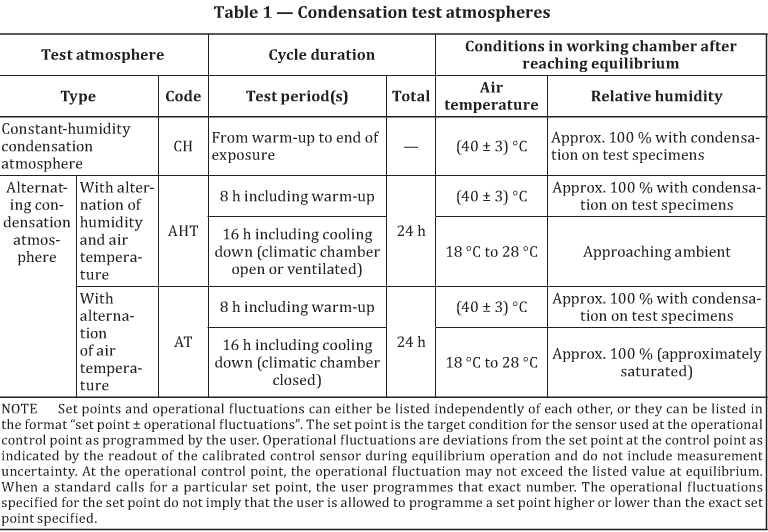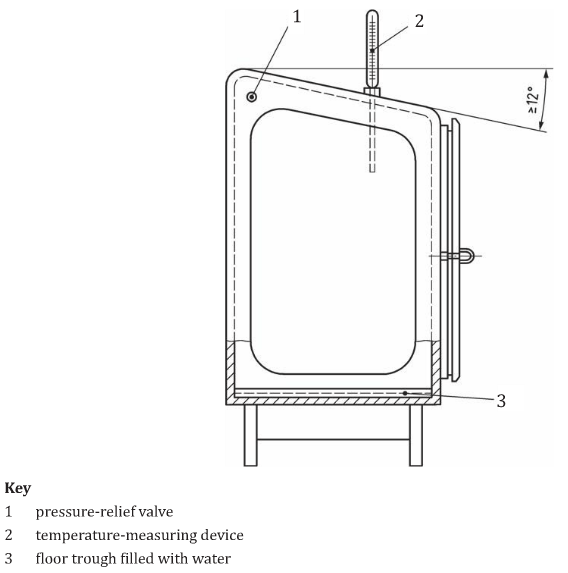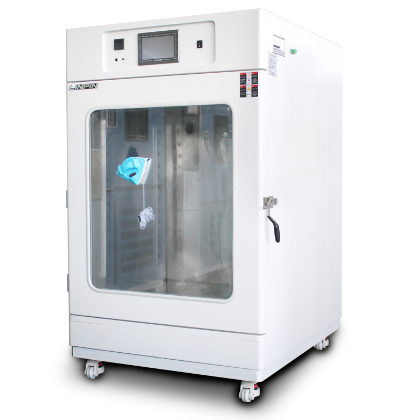Environmental Test Chambers for ISO 6270-2 Determination of resistance to humidity-Part 2: Condensation ( in-cabinet exposure with heated water reservoir)
This document specifies the general conditions and procedures which need to be observed when testing coated test specimens in constant condensation atmospheres or in alternating condensation-water atmospheres, in order to ensure that the results of tests carried out in different environmental test chambers are reproducible.
The condensation-water test atmospheres are designated as follows:
Test atmosphere CH Condensation atmosphere with constant humidity
AHT Condensation atmosphere with alternating humidity and air temperature
AT Condensation atmosphere with alternating air temperature
Temperature and humidity are important parameters affecting test results. Deviations from the requirements specified can lead to results that are not comparable. However, the interested parties may agree upon alternative parameters and these parameters shall be reported.
A coated test specimens is exposed to condensation in a climatic chamber, and the effects of the exposure are evaluated by criteria agreed in advance between the interested parties, these criteria usually being of a subjective nature.
Condensation-water test atmospheres promote the condensation of atmospheric humidity on the surfaces of test specimens, the temperature of which are lower than the temperature of the saturated air in the climatic chamber, due to radiation onto the chamber walls or to the cooling of the test specimen.
The atmosphere temperature in the climatic chamber during the condensation process described in this document is (40±3)℃.
The condensation-water test atmosphere may be either a constant-humidity (CH) or an alternating (AHT,AT) atmosphere. If, in addition to the action of the condensation water, the change in atmospheric temperature and the change in atmospheric humidity have an important effect on the test specimens. An alternating atmosphere should be chosen.
The quantity if condensation water formed on the surface of the coating may also exercise an important influence in the action of the water; this quantity will be affected by the ambient temperature in the installation room or by the cooling of the test specimens. The condensate which drips off the test specimens consists of condensation water and also, in some instances, of solid and liquid constituents of the coating dissolved in the condensation water or mixed with it.
Reproducible results can only be expected if the test procedure and test conditions remain constant for a series of tests. In case of alternating atmospheres, a cycle time of 24h shall be used as a general rule. A shorter cycle time (12h or 16h) and a correspondingly shortened time for the two test periods may be used for the AT test atmosphere.
The condensation-water test atmospheres are designated as follows:
Test atmosphere CH Condensation atmosphere with constant humidity
AHT Condensation atmosphere with alternating humidity and air temperature
AT Condensation atmosphere with alternating air temperature
Temperature and humidity are important parameters affecting test results. Deviations from the requirements specified can lead to results that are not comparable. However, the interested parties may agree upon alternative parameters and these parameters shall be reported.
A coated test specimens is exposed to condensation in a climatic chamber, and the effects of the exposure are evaluated by criteria agreed in advance between the interested parties, these criteria usually being of a subjective nature.
Condensation-water test atmospheres promote the condensation of atmospheric humidity on the surfaces of test specimens, the temperature of which are lower than the temperature of the saturated air in the climatic chamber, due to radiation onto the chamber walls or to the cooling of the test specimen.
The atmosphere temperature in the climatic chamber during the condensation process described in this document is (40±3)℃.
The condensation-water test atmosphere may be either a constant-humidity (CH) or an alternating (AHT,AT) atmosphere. If, in addition to the action of the condensation water, the change in atmospheric temperature and the change in atmospheric humidity have an important effect on the test specimens. An alternating atmosphere should be chosen.
The quantity if condensation water formed on the surface of the coating may also exercise an important influence in the action of the water; this quantity will be affected by the ambient temperature in the installation room or by the cooling of the test specimens. The condensate which drips off the test specimens consists of condensation water and also, in some instances, of solid and liquid constituents of the coating dissolved in the condensation water or mixed with it.
Reproducible results can only be expected if the test procedure and test conditions remain constant for a series of tests. In case of alternating atmospheres, a cycle time of 24h shall be used as a general rule. A shorter cycle time (12h or 16h) and a correspondingly shortened time for the two test periods may be used for the AT test atmosphere.

A vapour-tight climatic chamber is essential for testing in a warm and humid atmosphere. The material of the inner walls shall be corrosion-resistant and shall not affect the test specimens. The climatic chamber is usually equipped with a floor trough which acts as the receptacle for the quantity of water. The climatic chamber shall be controlled by heating the water in the floor trough.
If the quantity of heat introduced via the water is insufficient to raise the air temperature in the climatic chamber to the required level, then additional heating can be employed. The heating-up time will depend on the nature and quantity of the test specimens, and also on the ratio of the surface of the water in the floor trough to the surface of the walls of the climatic chamber, and on the water temperature. The water temperature should preferably not exceed 60℃ in order to prevent excessive vapour formation.
The climatic chamber shall be provided with a suitable door or other aperture capable of being closed, which allows the climatic chamber to be charged with test specimens and to be ventilated. Climatic chambers not equipped with water-filled floor troughs shall be fitted out in such way that adequate formation of condensation water on the test specimens is achieved.
If the quantity of heat introduced via the water is insufficient to raise the air temperature in the climatic chamber to the required level, then additional heating can be employed. The heating-up time will depend on the nature and quantity of the test specimens, and also on the ratio of the surface of the water in the floor trough to the surface of the walls of the climatic chamber, and on the water temperature. The water temperature should preferably not exceed 60℃ in order to prevent excessive vapour formation.
The climatic chamber shall be provided with a suitable door or other aperture capable of being closed, which allows the climatic chamber to be charged with test specimens and to be ventilated. Climatic chambers not equipped with water-filled floor troughs shall be fitted out in such way that adequate formation of condensation water on the test specimens is achieved.


The climatic chamber shall be installed in a room with an ambient atmosphere containing no corrosive constituents, at a room temperature of (23±5)℃ and at a relative atmospheric humidity of 75% max, in such way that it is protected against draughts and solar radiation. In case of comparison tests, the ambient temperature in the installation room shall be the standard temperature of (23±2)℃ in accordance with ISO 3270.
The device for accommodating the test specimens shall consist of a corrosion-resistant material and shall not promote the corrosion of the test specimens. It shall allow the test specimens to be arranged in accordance with the requirements.
The floor trough ( if there is one) shall be filled with water in such a way that a depth of water of at least 10mm is present at all times during operation. The use of ordinary tap water may cause calcification of the apparatus, so follow the instrument manufacturer’s instructions concerning the quality of the water used.
Only coatings which do not mutually influence one another shall be exposed together at any one time. If specimens are likely to be affected additionally by the quantity of condensation water formed, then the quantity of condensation water shall be ascertained by way of comparison within one test cycle or within a 24-h period, with the aid of a suitable device, for the purpose of describing the test conditions.
The test specimens shall be arranged in the chamber at any angle greater than or equal to 60° to the horizontal in such a way that they are not in close contact with each other and that they are able adequately to radiate heat.
The following minimum spacing shall be observed:
Distance from the walls not less than 100mm
Distance of the bottom edge of the test specimen not less than 200mm
from the surface of the water
Spacing between adjoining test specimens not less than 20mm
Precautions shall be taken to ensure that no condensation water is allowed to drip onto the test specimens from the walls or ceiling of the climatic chamber, nor from other test specimens. Make sure that condensation forms on all test specimens.
The device described below is suitable for the determination of the comparison quantity of condensation water:
An 18mm×18mm test tube , filled with water, is used as a standard specimen. The condensation dripping from the test tube shall be collected in a graduated measuring cylinder with a nominal capacity of 10ml via a glass funnel with a diameter of 55mm.
The device shall be arranged in the useful space amongst the ther specimens in the same way for the arrangement of the specimens, and the bottom of the test tube ( which shall itself be suspended from a thread of polyamide for example) shall be situated 50mm above the rim of the funnel placed in the graduated measuring cylinder.
This is standard ISO 6270-2. Our programmable water condensation test chamber can meet this requirements.
For more details, please feel free to contact sales@lenpure.com
Please visit www.lenpure.com
The device for accommodating the test specimens shall consist of a corrosion-resistant material and shall not promote the corrosion of the test specimens. It shall allow the test specimens to be arranged in accordance with the requirements.
The floor trough ( if there is one) shall be filled with water in such a way that a depth of water of at least 10mm is present at all times during operation. The use of ordinary tap water may cause calcification of the apparatus, so follow the instrument manufacturer’s instructions concerning the quality of the water used.
Only coatings which do not mutually influence one another shall be exposed together at any one time. If specimens are likely to be affected additionally by the quantity of condensation water formed, then the quantity of condensation water shall be ascertained by way of comparison within one test cycle or within a 24-h period, with the aid of a suitable device, for the purpose of describing the test conditions.
The test specimens shall be arranged in the chamber at any angle greater than or equal to 60° to the horizontal in such a way that they are not in close contact with each other and that they are able adequately to radiate heat.
The following minimum spacing shall be observed:
Distance from the walls not less than 100mm
Distance of the bottom edge of the test specimen not less than 200mm
from the surface of the water
Spacing between adjoining test specimens not less than 20mm
Precautions shall be taken to ensure that no condensation water is allowed to drip onto the test specimens from the walls or ceiling of the climatic chamber, nor from other test specimens. Make sure that condensation forms on all test specimens.
The device described below is suitable for the determination of the comparison quantity of condensation water:
An 18mm×18mm test tube , filled with water, is used as a standard specimen. The condensation dripping from the test tube shall be collected in a graduated measuring cylinder with a nominal capacity of 10ml via a glass funnel with a diameter of 55mm.
The device shall be arranged in the useful space amongst the ther specimens in the same way for the arrangement of the specimens, and the bottom of the test tube ( which shall itself be suspended from a thread of polyamide for example) shall be situated 50mm above the rim of the funnel placed in the graduated measuring cylinder.
This is standard ISO 6270-2. Our programmable water condensation test chamber can meet this requirements.
For more details, please feel free to contact sales@lenpure.com
Please visit www.lenpure.com











